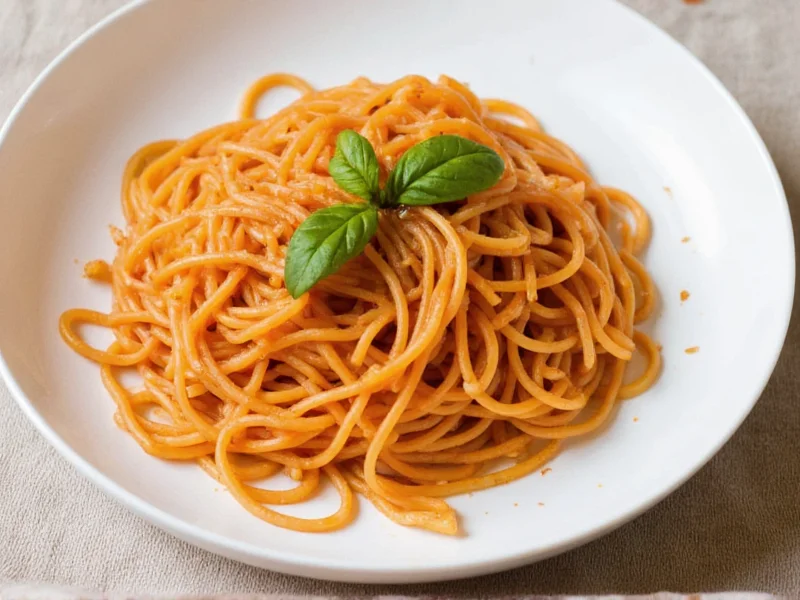Mastering the Fundamentals of Flavor Enhancement
Spaghetti perfection begins with understanding how flavors interact. Many home cooks make the critical mistake of treating sauce and pasta as separate components rather than a unified dish. The magic happens when you combine proper pasta water utilization with strategic ingredient layering. Professional chefs know that the final three minutes of cooking determine whether your spaghetti becomes memorable or mundane.
Essential Techniques for Elevating Basic Spaghetti
Before exploring creative additions, master these foundational methods that transform even the simplest spaghetti preparation:
Perfect Pasta Water Utilization
Reserve at least one cup of starchy pasta water before draining. This liquid gold contains the starches released during cooking that help sauces cling to noodles. When finishing your spaghetti in the saucepan, add small amounts of this water to create a silky emulsion that coats each strand evenly. This professional technique, known as mantecatura, prevents sauce from pooling at the bottom of the plate.
Building Flavor Layers
Start with quality extra-virgin olive oil in a cold pan, then add aromatics like garlic or shallots. Cooking aromatics slowly in cold oil extracts maximum flavor without burning. For tomato-based sauces, add a pinch of sugar only if needed to balance acidity, but prioritize using ripe, in-season tomatoes or high-quality canned San Marzano tomatoes instead of masking poor ingredients.
| Flavor Component | Recommended Addition | When to Add |
|---|---|---|
| Umami Boosters | Anchovy paste, dried mushrooms, tomato paste | With aromatics at beginning |
| Acidity Balancers | Red wine vinegar, lemon zest, quality balsamic | After sauce has reduced |
| Fresh Herbs | Basil, parsley, oregano | Final 30 seconds of cooking |
| Finishing Oils | Truffle oil, chili oil, herb-infused oil | At plating stage |
Creative Ingredient Additions for Spaghetti
Once you've mastered the fundamentals, explore these creative yet practical ways to spice up spaghetti that go beyond basic meatballs and red sauce.
Unexpected Umami Enhancers
Umami creates that satisfying savory depth that makes dishes memorable. Instead of reaching for monosodium glutamate, try these natural umami boosters that professional chefs use:
- Anchovy paste - A small amount (1/2 teaspoon) dissolved in olive oil with garlic creates incredible depth without fishy flavor
- Dried porcini mushrooms - Soak in warm water, then finely chop and add to sauce while reserving the flavorful soaking liquid
- Capers and olives - Add briny complexity to tomato or oil-based sauces
- Worcestershire sauce - Just a few drops enhances meat-based sauces
Herb and Citrus Transformations
Fresh herbs can completely transform spaghetti when used correctly. The timing of addition matters as much as the herb selection:
- Basil - Tear leaves rather than chopping to prevent bruising; add at the very end for maximum aroma
- Parsley - Flat-leaf holds up better in cooking; use stems in the sauce base and leaves for garnish
- Lemon or orange zest - Adds brightness to rich meat sauces; add during final plating
- Chili flakes - Bloom in olive oil first to distribute heat evenly rather than creating hot spots
Sauce Transformation Techniques
Most spaghetti disappointments stem from treating sauce as a separate element rather than an integrated component. These techniques ensure your sauce and pasta become one cohesive dish.
The Restaurant-Style Finish
Professional kitchens never serve pasta with sauce poured on top. Instead, they:
- Cook pasta to al dente (1-2 minutes less than package directions)
- Transfer directly to sauce with a splash of pasta water
- Finish cooking pasta in the sauce for 2-3 minutes over medium heat
- Add small amounts of pasta water as needed to create emulsion
- Remove from heat just before pasta reaches perfect doneness (it continues cooking)
Acidity Balance Secrets
Proper acidity makes flavors pop without tasting sour. Instead of adding sugar to tomato sauces:
- Use quality red wine vinegar (1/2 teaspoon at a time)
- Add a small piece of Parmesan rind while sauce simmers
- Incorporate a splash of high-quality balsamic reduction
- Finish with fresh lemon juice rather than during cooking
Protein Pairing Strategies
While meatballs are classic, these protein combinations create more interesting spaghetti experiences:
Seafood Spaghetti Options
For a lighter yet sophisticated meal:
- Garlic shrimp spaghetti - Sauté shrimp separately, then combine with pasta during final finish
- Clam or mussel spaghetti - Use the seafood cooking liquid as part of your sauce base
- Smoked salmon finish - Add delicate smoked salmon after plating for elegant presentation
Vegetarian Protein Enhancements
Plant-based proteins can add satisfying texture and nutrition:
- White beans - Cannellini beans add creaminess to tomato sauces
- Pine nuts - Toasted and added as garnish for crunch and richness
- Artichoke hearts - Marinated varieties add Mediterranean flair
Common Spaghetti Mistakes to Avoid
Even with great ingredients, these errors can ruin your spaghetti:
- Overcooking pasta - Always cook to al dente and finish in sauce
- Underseasoning - Salt pasta water generously (should taste like the sea)
- Adding oil to cooking water - Prevents sauce from adhering to pasta
- Serving sauce on top of pasta - Creates separation rather than integration
- Using dried herbs when fresh would shine - Reserve dried herbs for long-simmered sauces
Putting It All Together: A Flavorful Spaghetti Blueprint
Combine these techniques for restaurant-quality spaghetti at home:
- Bring generously salted water to boil (4-6 quarts water with 2-3 tablespoons salt)
- Cook spaghetti to al dente, reserving 1.5 cups pasta water
- While pasta cooks, build sauce base with cold oil and aromatics
- Add umami boosters and main sauce components, simmering to desired consistency
- Transfer pasta directly to sauce with 1/2 cup pasta water
- Finish cooking over medium heat, adding more pasta water as needed
- Remove from heat when pasta is slightly underdone
- Add fresh herbs, citrus zest, or finishing oil
- Plate immediately with additional garnishes











 浙公网安备
33010002000092号
浙公网安备
33010002000092号 浙B2-20120091-4
浙B2-20120091-4